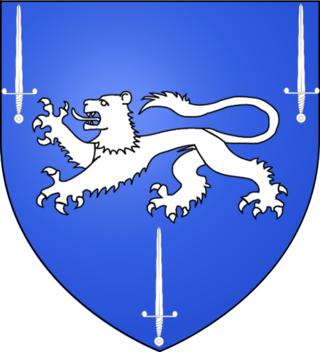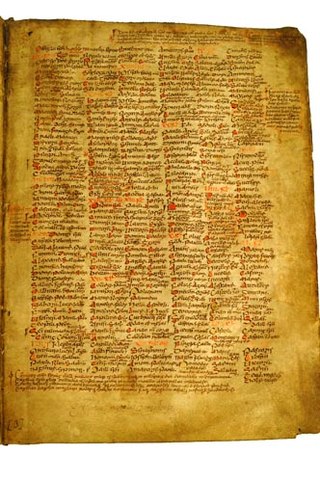This article includes a list of references, related reading, or external links, but its sources remain unclear because it lacks inline citations .(December 2024) |
Saint Gabhran was a 5th-century Irish saint.
This article includes a list of references, related reading, or external links, but its sources remain unclear because it lacks inline citations .(December 2024) |
Saint Gabhran was a 5th-century Irish saint.
Gabhran was an Irish Christian saint who lived about 460 AD. His father was Dubthach maccu Lughair, the Chief Ollam of Ireland. Gabhran's brothers were all saints and founders of churches, mainly in Leinster. They included Fachtna of Kiltoom, Trian, Saint Euhel, Moninne, Lonan and Saint Molaisse Mac Lugair.
The Martyrology of Donegal gives Gabhran's feast-day as 14 November as follows- “The three sons of Dubhthach, i.e., Fachtna of Cill-Toma, Gabhran and Euhel, the other two.”
The Martyrology of Gorman (Félire Uí Gormáin), for the same day gives- “Dear are the pure-formed, three godly sons of Dubthach”.

Iarlaithe mac Loga, also known as Jarlath, was an Irish priest and scholar from Connacht, remembered as the founder of the monastic School of Tuam and of the Archdiocese of Tuam, of which he is the patron saint. No medieval biography of Jarlath is extant, but sources for his life and cult include genealogies, martyrologies, the Irish Lives of St Brendan of Clonfert, and a biography compiled by John Colgan in the 17th century.
Mainchín mac Setnai, also anglicised to Munchin, was allegedly the founder of the church of Luimneach, Ireland, and a saint in Irish tradition, acquiring special eminence as patron of Limerick City. Both his origins and the date of his association with the city are debated.
Eithne and her sister Sodelb are two relatively obscure Irish saints from Leinster who are supposed to have flourished in the 5th century. They are commemorated together in the Irish martyrologies on 29 March, though 2 and 15 January were also marked out as feast-days. The 17th-century scholar John Colgan believed that a Life written for them had been witnessed in c. 1490 by Cathal Óg Mac Maghnusa, whom he regarded as the author of additions to the Félire Óengusso. Although nothing of the kind has come to light, they do make cameo appearances in the Lives of two better-known 6/7th-century saints, Áedan and Moling, both bishops of Ferns.

MacGorman, also known as McGorman, Gorman, or O'Gorman, is an Irish Gaelic clan based most prominently in what is today County Clare. The paternal ancestors of the clan are of the Laigin and emerged in what is today County Waterford. As leaders of the Uí Bairrche, they competed with the Uí Cheinnselaig in the 5th century for the Kingship of Leinster, ultimately losing out in that specific arena, but holding on to significant lands in the Leinster area.

The Martyrology of Tallaght, which is closely related to the Félire Óengusso or Martyrology of Óengus the Culdee, is an eighth- or ninth-century Irish-language martyrology, a list of saints and their feast days assembled by Máel Ruain and/or Óengus the Culdee at Tallaght Monastery, near Dublin. The Martyrology of Tallaght is in prose and contains two sections for each day of the year, one general and one for Irish saints. It also has a prologue and an epilogue.

Abbán of Corbmaic, also Eibbán or Moabba, was a saint and abbot. He is associated, first and foremost, with the Mag Arnaide. His order was, however, also connected to other churches elsewhere in Ireland, notably that of his alleged sister Gobnait.
Dubthach maccu Lugair, is a legendary Irish poet and lawyer who supposedly lived at the time of St Patrick's mission in Ireland and in the reign of Lóegaire mac Néill, high-king of Ireland, to which Dubthach served as Chief Poet and Brehon. In contrast to the king and his druids, he is said to have readily accepted the new religion. This event has played a major part in Hiberno-Latin and Irish sources as representing the integration of native Irish learning with the Christian faith.
Mainchín mac Colláin was an Irish saint in Corran who is supposed to have flourished in the late 5th or 6th century.
Saint Femia was an Irish Christian saint, a sister of Saint Felim of Kilmore and Saint Daig of Inniskeen.
Fachtna of Kiltoom in the barony of Fore, County Westmeath was an Irish Christian saint who lived about 460. His father was Dubhthach moccu Lughair, the Chief Ollam of Ireland.
Euhel was a 5th-century Irish saint who lived about 460 AD.
Saint Carláen was the Bishop of Armagh, Ireland, from 578 to 588.
Saint Fedelmid Find was the Bishop of Armagh, Ireland from 558 to 578.
Saint Senach was the Bishop of Armagh, Ireland from 598 to 610.
Saint Fiachra was the Bishop of Armagh, Ireland from 548 to 558.
Saint Ailill the Second was the Bishop of Armagh, Ireland from 526 to 536.
Saint Ailill the First was the Bishop of Armagh, Ireland from 513 to 13 January 526.

Saint Suibne was the Bishop of Armagh, Ireland from 715 to 21 June 730. He is notable for his portrait which is possibly the earliest contemporary representation of a bishop of Armagh.
Saint Fer dá Chrích mac Suibni was the Abbot of Armagh, Ireland from 758 to 18 May 768.
Dál Cormaic were a Gaelic dynasty located in South Kildare.